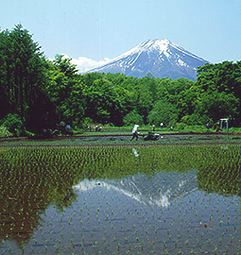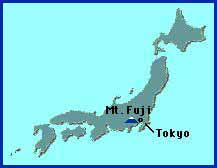ANNUAL CALENDAR July |
|
Opening of Climbing Season on Mt. Fuji
|
 July 1 is the day when Mt. Fuji, Japan's highest and most famous peak, formally opens for the climbing season. (The start of the mountain-climbing season is known in Japanese as yamabiraki, which literally means "mountain opening.") The shrines located near the base hold yamabiraki ceremonies on this day to pray for the safety of climbers.
July 1 is the day when Mt. Fuji, Japan's highest and most famous peak, formally opens for the climbing season. (The start of the mountain-climbing season is known in Japanese as yamabiraki, which literally means "mountain opening.") The shrines located near the base hold yamabiraki ceremonies on this day to pray for the safety of climbers.
Mt. Fuji, renowned throughout the world as a symbol of Japan, is situated near the center of Honshu, Japan's main island, and stretches 3,776 meters high (12,388 feet). It erupted frequently in the past, but volcanic activity has been dormant since 1707. It's cone-shaped, with wide foothills, and beautifully snow-capped.  The route to the summit is divided into 10 stages, or stations. On July 1, bus service to the fifth station (at an altitude of around 2,400 meters, or 7,870 feet) begins and lasts through August 31. It is usually from here that people who want to reach the peak begin their climb. After the climbers reach the sixth station, there are no more forests; only a few lonely scrub trees dot the landscape. Past the eighth station, even the low trees disappear, and the ground turns into bare gravel. At this point in their journey, many climbers nap at a mountain hut, starting out again a few hours later so they can reach the summit before daybreak, in time to watch the sun rise--one of the goals of most Mt. Fuji climbers. The sight of the sun rising over a thick carpet of clouds is truly breathtaking.
The route to the summit is divided into 10 stages, or stations. On July 1, bus service to the fifth station (at an altitude of around 2,400 meters, or 7,870 feet) begins and lasts through August 31. It is usually from here that people who want to reach the peak begin their climb. After the climbers reach the sixth station, there are no more forests; only a few lonely scrub trees dot the landscape. Past the eighth station, even the low trees disappear, and the ground turns into bare gravel. At this point in their journey, many climbers nap at a mountain hut, starting out again a few hours later so they can reach the summit before daybreak, in time to watch the sun rise--one of the goals of most Mt. Fuji climbers. The sight of the sun rising over a thick carpet of clouds is truly breathtaking.
After reaching the summit, some climbers enjoy an optional hike around the beautiful crater, which is 800 meters (2,620 feet) in diameter. This hike takes about an hour and a half. Finally, they descend the mountain, arriving back at the base before twilight. Despite its height, Mt. Fuji can be climbed by people of all ages. This is because the trails are relatively easy, toll roads can take climbers up to the fifth stage, and there are a multitude of huts (about 60 above the fifth stage) offering shelter. Cold-weather gear is always a necessity, though, since average temperatures at the summit stay below 6 degrees Celsius (42.8 degrees Fahrenheit) even in August.  From July 10 through August 20, the post office operates a branch at the top of the mountain. At this post office, climbers can send regular mail (such as the picture postcards offered for sale in the summit shop) or buy certificates to prove they have made it to the top of Mt. Fuji.
From July 10 through August 20, the post office operates a branch at the top of the mountain. At this post office, climbers can send regular mail (such as the picture postcards offered for sale in the summit shop) or buy certificates to prove they have made it to the top of Mt. Fuji.
Roughly 500,000 people climb the mountain each summer.
Photos: (Top) Mt. Fuji is a favorite subject for photographers, both professional and amateur (Hirokazu Kito); (middle) the mountain quietly watches over the lives of those who live around it (Shinji Ochi); (above) it's located approximately in the middle of the Japanese archipelago. |
APR | MAY | JUN | JUL | AUG | SEP | OCT | NOV | DEC | JAN | FEB | MAR |
 |